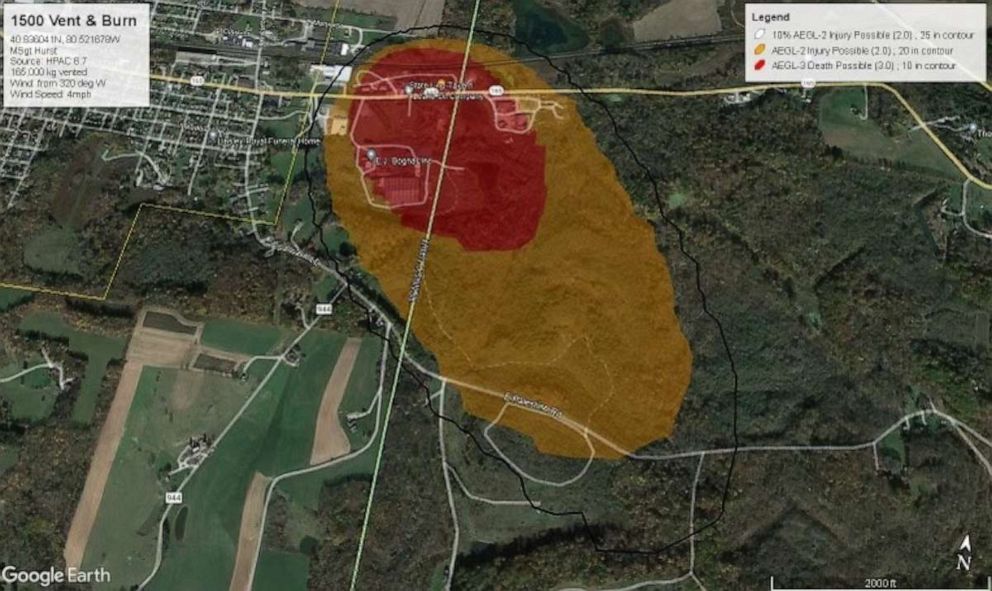Ohio Train Derailment Aftermath: Persistent Toxic Chemical Contamination Of Buildings

Table of Contents
Types of Toxic Chemicals and Their Impact on Buildings
The derailment released a cocktail of toxic chemicals, posing significant risks to the structural integrity and habitability of nearby buildings.
Vinyl Chloride and its Persistence
Vinyl chloride, a known carcinogen, is particularly concerning due to its volatility and ability to penetrate porous materials. Its persistence in building materials presents a long-term health hazard.
- Building materials affected: Vinyl chloride can contaminate porous materials like drywall, insulation, wood, and fabrics. It can also accumulate in HVAC systems, leading to persistent indoor air contamination.
- Potential health consequences of long-term exposure: Long-term exposure to vinyl chloride is linked to an increased risk of liver cancer, brain cancer, and other serious health problems.
- Difficulties in detection and remediation: Detecting vinyl chloride contamination requires specialized equipment and expertise. Remediation can be complex, often requiring extensive cleaning, replacement of contaminated materials, and air filtration systems.
Other Contaminated Substances
Beyond vinyl chloride, other chemicals released during the derailment, such as butyl acrylate and ethylhexyl acrylate, also pose significant risks. These chemicals can individually and synergistically impact building materials and human health.
- Specific effects on building materials: Butyl acrylate and ethylhexyl acrylate can damage certain building materials, leading to structural weaknesses and potential long-term deterioration.
- Potential synergistic effects with vinyl chloride: The combined effect of these chemicals may exacerbate the health risks associated with exposure. Further research is needed to fully understand these interactions.
- Challenges in identifying and removing these substances: Identifying and removing these substances requires specialized analytical techniques and remediation strategies tailored to the specific chemical and building materials involved.
Methods of Building Contamination
The spread of toxic chemicals from the Ohio train derailment impacted buildings through various pathways:
Airborne Contamination
Airborne chemicals dispersed from the derailment site can settle on building surfaces, penetrate HVAC systems, and accumulate indoors.
- Factors influencing airborne dispersal: Wind patterns, building design (e.g., ventilation systems), and atmospheric conditions significantly influence the dispersal of airborne contaminants.
- Methods of assessing airborne contamination levels: Specialized air sampling and analysis techniques are crucial for assessing the levels of airborne contamination in affected buildings.
Water Contamination
Groundwater contamination poses a long-term threat, affecting building foundations, plumbing systems, and even interior spaces.
- Potential for long-term leaching of chemicals into the groundwater: Chemicals can leach into groundwater, potentially contaminating water sources used for drinking and other purposes, and compromising building foundations.
- Methods of detecting water contamination: Water samples need to be analyzed for the presence of various contaminants. This necessitates specialized laboratory testing.
- Long-term effects on building integrity: Groundwater contamination can lead to structural damage, foundation instability, and other long-term issues affecting building integrity.
Direct Contact Contamination
Direct contact with spilled chemicals can contaminate building exteriors and interiors.
- Examples of direct contact contamination: Runoff from the derailment site, direct physical contact with spilled chemicals, and the deposition of contaminated materials can all contribute to direct contamination.
- Difficulty in cleaning highly porous materials: Cleaning highly porous materials like wood and concrete can be extremely challenging, requiring specialized cleaning techniques.
- Potential for hidden contamination: Contamination may be hidden within building materials, making detection and remediation difficult.
Long-Term Health Risks and Remediation Efforts
The persistent contamination from the Ohio train derailment presents significant long-term health risks and remediation challenges.
Health Impacts of Persistent Contamination
Exposure to the released chemicals poses several long-term health risks to residents and workers in contaminated buildings.
- Specific health risks associated with each chemical: Each chemical presents unique health risks, ranging from respiratory problems to various forms of cancer. Long-term studies are crucial to assess the full range of health consequences.
- Long-term monitoring needs: Continuous monitoring of affected populations is essential to track the incidence of health problems and assess the long-term effects of exposure.
- Challenges in establishing causality between exposure and health issues: Establishing a direct link between exposure to specific chemicals and health problems can be complex due to multiple factors affecting human health.
Remediation Challenges and Strategies
Remediating contaminated buildings is a complex and expensive undertaking.
- Costs associated with remediation: The cost of remediation can vary widely depending on the extent of contamination, the building materials involved, and the chosen remediation strategy.
- Challenges in assessing the extent of contamination: Accurately assessing the extent of contamination can be difficult due to the complex nature of the contamination and the potential for hidden contamination.
- Long-term monitoring requirements: Even after remediation, long-term monitoring is necessary to ensure the effectiveness of the remediation efforts and to detect any potential recurrence of contamination.
Conclusion
The Ohio train derailment has highlighted the devastating and long-lasting consequences of toxic chemical contamination on buildings and public health. The persistent nature of the contamination, the variety of affected building materials, and the significant health risks underscore the need for comprehensive and ongoing remediation efforts. The long-term effects of the Ohio train derailment on building safety demand continued vigilance. Stay informed about the latest developments, advocate for thorough remediation efforts, and help ensure the safety and well-being of affected communities. Continued monitoring, robust investigation, and effective remediation strategies are crucial to address the lingering impact of this environmental disaster and protect the health of those affected by the Ohio train derailment.

Featured Posts
-
 Jessica Simpson And Jeremy Renner A Look At Their Past And Present Relationship
May 11, 2025
Jessica Simpson And Jeremy Renner A Look At Their Past And Present Relationship
May 11, 2025 -
 L Autruche De Mask Singer 2025 Indices Pronostics Et Revelations
May 11, 2025
L Autruche De Mask Singer 2025 Indices Pronostics Et Revelations
May 11, 2025 -
 Grand Slam Track A Bold New Vision For The Future Of Athletics
May 11, 2025
Grand Slam Track A Bold New Vision For The Future Of Athletics
May 11, 2025 -
 Uncovering Alex Winters Pre Freaked Mtv Sketch Comedy Shows
May 11, 2025
Uncovering Alex Winters Pre Freaked Mtv Sketch Comedy Shows
May 11, 2025 -
 Cody Bellinger And Aaron Judge A Yankees Lineup Strategy
May 11, 2025
Cody Bellinger And Aaron Judge A Yankees Lineup Strategy
May 11, 2025
